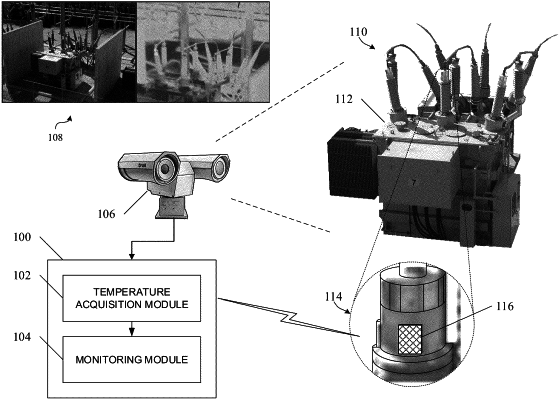| CPC H04N 5/33 (2013.01) [G01J 5/0096 (2013.01); G01J 5/025 (2013.01); G01R 31/62 (2020.01); G01J 2005/0077 (2013.01)] | 17 Claims |

|
1. A method, performed by processing circuitry, for remote monitoring of electrical equipment, the method comprising:
receiving a scene, provided by an infrared (IR) camera, of an image of electrical equipment to be monitored, the electrical equipment comprising at least one of a transformer, a bus bar, or a metal conductor within an electrical power substation;
partitioning the scene into a plurality of fixed, non-overlapping areas, each area comprising a fixed set of pixels that displays a fixed portion of the electrical equipment to be monitored;
assigning each of the plurality of areas to one or more groups, each group containing at least two of the plurality of areas;
acquiring a plurality of data values, one for each of the fixed, non-overlapping areas, by determining a minimum, maximum, or average intensity of all of the pixels contained within the respective fixed, non-overlapping area without converting the intensity values to temperature values;
defining an alarm condition for each of the one or more groups, wherein each alarm condition defines a condition indicative of potential equipment failure of which the operator should be alerted, based on an analysis of the data values of the fixed, non-overlapping areas assigned to that group, wherein the alarm condition for each of the one or more groups comprises at least one of:
detecting that a variance or standard deviation of data values from the fixed, non-overlapping areas in the group exceeds a threshold amount;
detecting that a change of variance or standard deviation of data values from the fixed, non-overlapping areas in the group over time exceeds a threshold rate;
detecting that a variance or standard deviation of data values from the fixed, non-overlapping areas in the group differs from a variance or standard deviation of data values from the fixed, non-overlapping areas in another group by a threshold amount;
detecting that a change of variance or standard deviation of data values from the fixed, non-overlapping areas in the group over time differs from a change of variance or standard deviation of data values from the fixed, non-overlapping areas of another group by a threshold amount; or
detecting that data values from the fixed, non-overlapping areas in a first group differ from data values from the fixed, non-overlapping areas in a second group by a threshold amount, wherein the first group corresponds to portions of a first equipment and the second group corresponds to portions of a second equipment, and wherein the first equipment and second equipment are subject to a same set of environmental conditions;
detecting that the alarm condition for one of the one or more groups has been met; and
in response to detecting that the alarm condition for one of the one or more groups has been met, providing an operator alert that the alarm condition for the one of the one or more groups has been met.
|